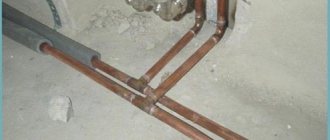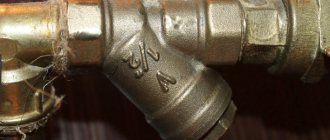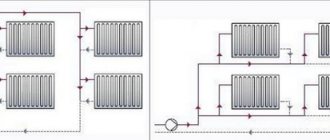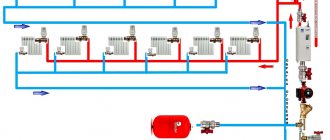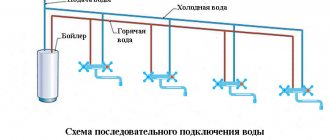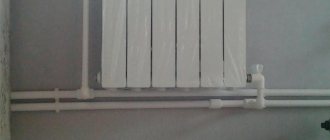In order for the heating system to work flawlessly and as efficiently as possible, only high-quality equipment must be used. But at the same time, we should not forget about the substance that will be involved in heat exchange in the system between its various elements, since all systems work on the same principle: there is a heat source, there are several radiators, and there is a substance that transfers heat from the sources to them. Consequently, the coolant for heating systems also plays an important role.
- 1 Types of coolants
- 2 Water
- 3 Antifreeze
- 4 Ethylene glycol
- 5 Propylene glycol
- 6 Mixtures of water and ethyl alcohol
- 7 Coolant for solar systems 7.1 Selection of coolant for heating
Read about the technical characteristics of the main types of radiators here
But first, let's figure out what kind of coolants there are.
Introductory video
Types of coolants
There are some requirements for any coolant, regardless of its type. Here they are:
- It must be inert to the materials used to manufacture the system.
- It must have the appropriate viscosity.
- Good heat capacity.
- Same good heat dissipation.
Following from this, we can identify the following categories of heating fluids:
- Liquid.
- Gaseous.
Liquids include water and antifreeze, which we will discuss later. Gaseous ones are in most cases ordinary air or steam. Actually, heated air is the first coolant. Now they are used extremely rarely, so we will not consider them in detail.
Water
Water is the simplest and at the same time the most inexpensive way to transfer heat from the source to the radiators. If we compare water with other substances in percentage terms, then it accounts for about 70 percent. Actually, this is not surprising, since water is not toxic, although it still has disadvantages. First of all, this is high corrosion activity during contact with metals, as well as the fact that scale forms on the surface of the heat exchanger over time.
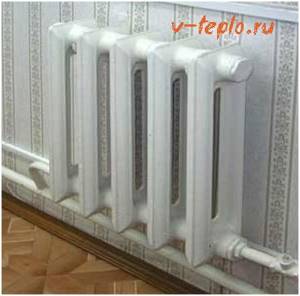
But the advantages that such a coolant has for heating systems are also significant: low cost and relative ease of use. Moreover, today a lot of inhibitors are sold, which several times reduce the harmful effects of water on the elements of the heating system. With the use of inhibitors, it becomes inert, which has a positive effect on the service life of the equipment.
Now about the cost. Using water costs practically nothing, unless you buy an additional inhibitor, but this, we repeat, is additional. But if heating will not be used regularly in winter, then it is advisable to abandon water altogether and resort to antifreeze.
Antifreeze for aluminum radiators: types, how to make it yourself?
Why do you need antifreeze for aluminum radiators?
Increasingly, individual houses are equipped with autonomous heating systems, in which modern lightweight aluminum radiators are installed. They have an unobtrusive, laconic design. They have several design varieties: panels, tubular and sectional batteries.
And not a single customer is surprised that after installing the equipment, specialists feed the system with water, ordinary water. Many, having forgotten their school chemistry lessons, do not even remember that aluminum is an active metal and begins to corrode in contact with water.
In addition, the water is “rich” in mineral salts, which is why scale forms during the boiling process. Further, salts and scale are deposited on the inner walls of the radiator and pipes, which very quickly leads to disastrous consequences.
Not everyone knows that there are alternative heat carriers in heating circuits that do not freeze or cause corrosive processes in metals. Moreover, they do not harm human health in emergency situations. You can read about why antifreeze is used in heating systems and how to make it yourself in this review of the construction magazine samastroyka.ru
Antifreeze for aluminum radiators: types and application
Usually this coolant is associated with cars and is considered the only possible way to use it. But even antifreeze used in cars has several varieties.
Non-freezing heating fluid contains various additives and additives that act as inhibitors of corrosion processes. Therefore, you should choose a composition that is intended for heating systems and produced by manufacturers, taking into account all the nuances of the intended use. In addition, antifreeze has a long service life: up to 10 years.
Of course, antifreeze is not ideal either:
- if it is produced on the basis of ethylene glycol, it is toxic;
- it has a lower thermal capacity than water;
- antifreeze for aluminum radiators can only work in a system with forced circulation; its viscous structure does not allow it to move by gravity;
- when heated, antifreeze expands greatly;
- its fluidity is one and a half times higher than water, therefore, you need to carefully monitor the seams and joints;
- It is prohibited to connect a water heating system to the antifreeze circuit.
Types of antifreeze
Today, several types of antifreeze are used in heating systems: based on ethylene glycol and propylene glycol. Ethylene glycol antifreeze is toxic, but cheaper in price compared to propylene glycol.
In addition, the main advantages of propylene glycol are the lack of toxicity during operation and the formation of sediment in heating systems. Unfortunately, such antifreeze for aluminum radiators is quite expensive, so many people choose ethylene glycol-based antifreeze.
How to make antifreeze with your own hands
Antifreeze with additives is quite expensive, so it does not always suit the consumer. But there is no need to despair. You can prepare the composition yourself. A homemade solution is even better than an industrial solution.
It has a lower viscosity and less fluidity, so it does not have a strong destructive effect on joints and seams in the heating system. Moreover, the use of homemade compounds causes significantly less damage to rubber gaskets, which are essential for heating installation.
To prepare the solution you need to take forty percent ethyl alcohol and purified water. It is better to take hard water, since in combination with ethyl alcohol, such water prevents scale and sediment from settling inside the system. Any sediment that does settle is easily removed by flushing the heating circuit under pressure.
The percentage of alcohol should not exceed 30%, then the alcohol does not evaporate, and the heat carrier behaves like water. This means that the boiling point will be the same as that of water. When the coolant is heated to 85-90°C, there is no boiling, which does not produce much vaporization.
And, one of the most important characteristics of such a mixture is that ethanol prevents water from freezing. This means that in winter, during emergencies or regular heating shutdowns, there is no danger of the system defrosting.
In what proportions should you mix water and alcohol for antifreeze?
The percentage of ethanol in the composition should be proportional to the air temperature outside the window.
| Air temperature | % alcohol |
| — 10,6 | 20,3 |
| — 23,6 | 33,8 |
| — 28,7 | 39,0 |
| — 33,9 | 46,3 |
In addition, it is useful to remember that a liter of 96% ethyl alcohol, anhydrous alcohol, contains only 960 ml. Accordingly, to obtain a solution with 30% ethanol, you need 96/30 = 3.2, which means that for 1 liter of alcohol you need to take 3.2 liters of water.
These proportions allow antifreeze not to freeze at temperatures down to -20o C.
What you shouldn't forget
There are restrictions on the use of any antifreeze as a coolant, even self-prepared ones.
It is prohibited to use antifreeze:
- in systems with electrolysis boilers;
- in open systems;
- when the system is installed using galvanized elements.
If you plan to use antifreeze in the heating circuit, experts do not recommend installing equipment using flax tow placed on paint. The Unipack plumbing kit is perfect for this.
Use at temperatures below -20°C (which means that the percentage of alcohol in antifreeze must be increased) leads to the formation of scale in the form of a difficult to wash out sediment inside pipes and radiators.
Important! If the planned operating temperature in the circuit is above 70°C, then the use of antifreeze is undesirable. Because the high expansion of water provided by alcohol can lead to an emergency.
Professionals recommend planning a system using antifreeze in advance, since such a system has its own nuances: boiler power, equipment made from certain materials. Re-equipping it after using water as a coolant will not be cheap.
If necessary, you can add only the same brand of media that was originally used.
Fill the heating circuit with antifreeze for aluminum radiators, or choose another coolant - the owner of the house will decide. It’s just important to know that this option also has a right to exist.
(3 5,00 of 5) Loading...
Source: https://samastroyka.ru/antifriz-dlya-alyuminievyx-radiatorov.html
Antifreeze
So, if you have chosen antifreeze, then you should know that it should not be easily flammable, and it should not contain poisonous or toxic substances.
Important! Do not use antifreeze, ethyl alcohol or transformer oil as a heating fluid! After familiarizing yourself with safety precautions, you will find out for yourself that only those substances that were specially created for this purpose should be used for heating.
It is advisable to use a special certified antifreeze, for example, dixis 65 is very popular today. Often, all coolants of this type are made on the basis of two substances:
- Propylene glycol.
- Ethylene glycol.
Coolant for aluminum radiators. kinds. antifreeze,
Sometimes residents of the private sector make a very important mistake when they install autonomous heating with aluminum radiators and do not think about the fact that in such cases plain water is not suitable as a coolant.
In addition, such a liquid is not the only one of its kind - there are various options and you cannot do without it, due to the fact that simple water with its salts and alkalis will destroy aluminum, and this will certainly not suit you, so In any case, you need to look for a way out.
We will now tell you about the different types of the drug, the conditions for its use, and invite you to watch the video in this article.
How he is not uncommon in the grand scheme of things
Note on the image. Depending on the method of supplying fluid to the batteries, as shown in the top image, the degree of heat transfer may change.
- The most used and in demand coolant all over the world for water heating systems is, of course, water , but its use leads to metal corrosion and the formation of scale and sludge, therefore, there is a need for periodic flushing and cleaning of the system. In addition, you do not have the opportunity to turn off the heating in the winter without draining the coolant at the same time, since the water, of course, will freeze and what is called “system defrosting” will happen - pipes and/or radiators burst - simply put, it comes out out of service.
- From all this it is possible to conclude that it is fundamentally important not only to correctly calculate the power of the batteries for the room, but at the same time to use a coolant that does not freeze and enters into a chemical reaction with the metal . Such special liquids have one important property, which the instructions show, and you need to pay attention to this when purchasing - in the event of a system leak, such a coolant does not affect the health of the human body.
Antifreeze as a coolant
Note. Antifreeze, which can almost be translated into Russian from English, as “anti-freeze” is used to name liquids that do not freeze at low temperatures, as a non-specialized concept for such drugs. But in this case, there are special additives or additives - they serve as inhibitors of corrosion and mineral deposits.
But no matter what, when choosing antifreeze for aluminum radiators, you should choose exactly the composition that is intended for this purpose, since the manufacturer intends to provide for all the nuances of the intended use.
But there is no need to look at such a coolant as some kind of panacea - it, quite naturally, has its own disadvantages:
- Compared to water, its thermal capacity is 115% lower;
- It is impossible to start the system without a circulation pump, since antifreeze has a high viscosity and circulation will be inhibited;
- When heated, a liquid expands greatly;
- Its fluidity is 50% higher than the fluidity of water - this forces us to pay special attention to welded (solder) and threaded connections;
- When using ethylene glycol antifreeze, it is unrealistic to connect a warm water supply system, and only one circuit for heating, since they are poisonous.
Ethanol based antifreeze
Note. If you do not have the opportunity to buy a sufficient number of similar mixtures for a heating system with aluminum radiators, you have the opportunity to make them yourself, but for this you will need distilled water and 40% ethanol (ethyl alcohol).
The high price of such coolants may not allow their use for your own autonomous system, and then you will need forty percent ethyl alcohol and distilled water, which will allow you to prepare the necessary liquid yourself.
It is curious that this composition is to some extent better than the factory one, since its viscosity is much lower, but at the same time, it is in sufficient proportion higher than that of water, and in addition to this, the fluidity is also significantly reduced, which makes it possible to lower the requirements to a certain extent to welded (solder) and threaded connections.
In addition, it is important to emphasize that the use of such compounds does not damage the rubber seals (gaskets), which you will use in any case when installing the circuit.
Here you should also pay attention to the fact that it is optimal to use solid water when preparing the composition - it, together with ethanol, does not allow scale to form on the inner surface of the walls of pipes and devices.
It goes without saying that hard sediment will inevitably form under such conditions, but it is easily removed by flushing the system with running water. If the content of ethyl alcohol in water does not exceed the 30% barrier, then alcohol evaporation will not occur - the liquid will behave exactly like simple, clean water.
Due to its identification with simple water, the boiling point for the coolant is approximately at the same level as water, therefore, if the liquid is heated to 85-90?, then there is no abundant release of steam, since there is no boiling.
And finally, ethanol significantly reduces the thermal expansion of H2O, therefore the risk of pipes and/or battery ruptures when the system defrosts is significantly reduced.
Proportions
It should be taken into account that a certain decrease in temperature should be accompanied by an increase in the percentage of ethanol to distilled water, so if the thermometer drops to -10.6? C, then the content of ethyl alcohol in the total composition should be no less than 20.3%.
If the temperature drops to -23.6?C, then 33.8% ethanol will be required, at a temperature of -28.7?C - 39% alcohol and at a temperature of -33.9?C - 46.3%, respectively.
But that’s not all - one liter of 96% ethylene contains 960 ml of anhydrous alcohol, therefore, in order to have a 33% solution, you need to divide 96/33 = 2.9, in other words, 2.9 liters of distilled water.
This means that to obtain a 33% solution we need one liter of ethyl alcohol and 2.9 liters of distilled water. This composition will serve as an excellent coolant for a circuit with aluminum radiators, which will not freeze even at -22.5? C.
But this composition, in other words, the antifreeze, the preparation of which we have outlined, and indeed each one, in certain cases is strictly prohibited, based on this, you will need to take into account certain factors:
- The use of antifreeze in heating systems that use electrolysis boilers is not permitted.
- The use of antifreeze in open heating systems where ethylene glycol is used is strictly prohibited, since it is poisonous.
- It is not recommended to lower the temperature beyond -20? C, since this reduces the quality characteristics of the additives used - scale will appear on the inside of the walls.
- When using such coolants, it is not recommended to use flax tow placed on paint, since ethyl alcohol easily corrodes it and the connection becomes depressurized. Unipak plumbing paste is well suited for this.
- In addition, in such cases, galvanized pipes, pipes and fittings cannot be used in the system.
Conclusion
It goes without saying that it is up to you to decide which coolant to choose for aluminum radiators, but I would like to draw attention to one more feature of such circuits in combination with an antifreeze coolant.
If the operating temperature of the heating system is more than 70? C, then it is better for you to refrain from using similar mixtures. The fact is that at such temperatures, thanks to alcohol, the liquid will have a large expansion, which is unsafe for the entire system.
Source: https://uchebniksantehnika.ru/otoplenie/teplonositel-dlia-aliuminievykh-radiatorov-vidy-antifriz.html
Ethylene glycol
It is worth knowing that ethylene glycol is very dangerous, so it should be used with extreme caution. So, if the walls of the system are damaged, the consequences can be very dire. So its use in double-circuit boilers is undesirable. In addition, ethylene glycol is strictly prohibited from being used in cases with open expansion tanks, since if it enters the human body (especially a substance with the third hazard class), it will negatively affect health. Although it is impossible to recognize it by smell due to its absence, there is only a slight sweetish aftertaste. So all this is very dangerous and requires caution.
Today, almost all antifreezes in the world are made based on ethylene glycol. Its cost is approximately 80 rubles per kilogram.
Antifreeze for aluminum car radiators. Choosing antifreeze: better red or green
What antifreeze is best to use? 3.67/5 (73.33%) 6 votes
Each of them has its own specific composition, its own additives, and has its own properties and characteristics. Why can’t they be mixed, how do they differ, what kind of antifreeze is best to fill in , and how to drain the coolant? Questions that concern many car owners.
Review of popular brands
In our country, various brands of ethylene glycol-based antifreeze are used. The most popular include “Felix”, “Alaska”, “Sintek”, Long Life, Nord. They are characterized by an optimal price-quality ratio.
The presented antifreezes are designed for the harsh conditions of our climate. Also, the developed line of products allows the driver to select the required product for the engine of his car. The presented products effectively resist the formation of corrosion and also provide good cooling properties of the radiator.
Products popular in our country today effectively protect engine systems from the formation of deposits, especially in the water pump, engine compartment and supply channels.
Pros and cons of aluminum radiators
The popularity of aluminum batteries is explained by the following advantages of the products:
- Light weight. The weight of one section does not exceed 2 kg.
- Cheapness. Aluminum is a common metal that is easy to process.
- Easy installation and maintenance. The coating is heat-resistant paint that is easy to clean.
- Excellent decorative characteristics.
- High level of heat transfer. This is facilitated by additional ribs with thin walls. According to this indicator, aluminum radiators are almost 3 times superior to conventional cast iron batteries.
- Compact sizes.
- Fast response to temperature switching due to the low thermal “inertia” of aluminum.
Weaknesses of aluminum radiators:
- Very sensitive to the composition of the coolant (hardness, mineralization). Poor water quality often causes equipment failure. Therefore, deciding which antifreeze is best for a radiator must be taken seriously.
- Tendency to corrosion. Design, installation and repair must be carried out very carefully.
- Working pressure restrictions.
- High probability of formation of air pockets due to the chemical activity of the metal with salts dissolved in water
The choice of coolant for aluminum radiators must be done very carefully.
Antifreeze as a coolant
When solving the problem of which coolant to choose for aluminum radiators, it is important to find a specific composition intended specifically for the intended use.
It is important to consider the following disadvantages of antifreeze liquid for aluminum radiators:
- Low level of thermal capacity (inferior to water by almost 115%).
- A circulation pump is required. Without it, the system will not work due to the high viscosity of the antifreeze, which creates additional obstacles to the movement of the coolant along the circuit.
- Noticeable increase in volume when heated.
- Very high fluidity (50% more than water). Because of this, special attention has to be paid to welded (solder) and threaded connections.
- The toxicity of some compounds. We are talking, first of all, about ethylene glycol antifreeze, which must not be used in combination with hot water supply.
Propylene glycol for heating systems
Propylene glycol is non-toxic
Propylene glycol antifreeze for heating systems is an alcohol composition with the addition of propylene. We started with him because he is the one that has an advantage over other lineups. Why is he so good? The main thing is that it is non-toxic. Now let's return to what kind of antifreeze can be used in double-circuit boilers.
As you already understand, propylene glycol antifreeze is best suited for heating systems with a dual-circuit heater. Even if part of the coolant gets into the hot water supply circuit, it will not cause any harm to a person. Contact with the skin and even inside the body, although undesirable, is not fatal. If in small doses, then there will not even be poisoning.
Some varieties of propylene glycol, namely the food additive E1520, are used as moisture-retaining and softening agents in the food industry. This additive is used in the production of natural essences and dyes, which are then added to confectionery products.
The characteristics of anti-freeze products are similar, but there is a qualitative difference between them. That is, propylene glycol has better characteristics than other antifreezes. The only thing that can be considered a disadvantage is its price, which is twice as much as ethylene glycol.
- non-toxic;
- high performance additive package;
- Expensive.
The service life is five years, after which it is necessary to completely replace the antifreeze in the heating. Otherwise, the additive package will stop working and the corrosive effect of the antifreeze will turn the heating circuit into an emergency one in a short time.
Ethanol compounds
The significant cost of this antifreeze for aluminum radiators often becomes a serious obstacle to its use in private autonomous systems. The composition can be obtained from distilled water and 40% ethanol (ethyl alcohol).
The quality of such a solution is superior to the factory analogue in certain parameters. The matter mainly concerns its low viscosity (although compared to water it remains quite high).
There is also a decrease in fluid fluidity, which makes it possible to be less demanding on the connecting areas.
The use of homemade ethanol antifreeze for heating radiators has a beneficial effect on the safety of the rubber sealing gaskets that are present in any circuit.
It is recommended to dilute alcohol with hard water: in combination with ethanol, it will become a serious obstacle to the formation of scale on the inner walls. In this case, you cannot do without solid sediment, but you can easily get rid of it by flushing the system.
In cases where the percentage of ethyl alcohol in water does not exceed 30%, it will not evaporate.
Due to the fact that the coolant for aluminum radiators is similar in its characteristics to water, its boiling point is approximately the same as that of water.
This suggests that when the temperature reaches + 85-90ᶷ, no steam release will be observed.
Thanks to ethanol, the thermal expansion of water is reduced by an order of magnitude, which allows the system to more comfortably tolerate lower temperatures in the room.
Ethylene glycol for heating systems
Molecular structure of ethylene glycol
Very poisonous composition. Moreover, it is poisonous both in liquid and gaseous form. If you pour such antifreeze into an open heating system, then the design of the expansion tank must be modified.
It must have a lid that closes tightly. Holes must be made in the lid to allow gases to escape. Insert a pipe into the hole (also hermetically sealed) and take it outside the room, to the street.
Contact with skin or eyes is highly undesirable. Therefore, even an ordinary fistula can become a serious danger to others. Under no circumstances should it be used in double-circuit heaters, the danger is very serious, do not tempt fate. This is an inexpensive composition. The additive package of ethylene glycol is not as high quality as that of propylene glycol, which is why it is cheaper.
The toxicity is so great that a dose of 350 mg can send a healthy person weighing 80 kg to the next world.
What we have as a result:
- very high toxicity;
- low quality additive package;
- cheap.
The service life is approximately the same as the previous composition. It is also five years, after which a complete replacement is required.
What proportions to use
It is important to understand that to lower the freezing point it is necessary to increase the percentage of ethanol in the solution:
- When the indicator drops to -10.6 degrees, ethyl alcohol must be present in an amount of at least 20.3%.
- When the temperature drops to -23.6 ᶷ degrees, the share of ethanol increases to 33.8%.
- At a temperature of -28.7 degrees, alcohol is added in a volume of 39% alcohol.
- At a temperature of -34 degrees - 46.3%.
It should be taken into account that one liter of 96% ethylene contains 960 ml of anhydrous alcohol. Therefore, to obtain a 33% solution, you will need 96/33 = 2.9, that is, 2.9 liters of distilled water.
That is, to make a 33% solution you need one liter of ethyl alcohol and 2.9 liters of distilled water. The antifreeze obtained in this way for heating can be safely poured into a circuit with aluminum radiators, because
it will retain its fluidity even at -22 degrees below zero.
There are certain restrictions on the use of homemade and factory-made non-freezing coolants for bimetallic radiators:
Source: https://OmShantiDom.ru/radiatory-otopleniya/antifriz-dlya-alyuminievyh-radiatorov-avtomobilej.html
Propylene glycol
But propylene glycol is safer in terms of toxicity, that is, it is completely non-toxic, so it is allowed to be used in all countries. Moreover, it can even often be found in food (look for it under code E 1520). So, the advantages of the substance include complete safety in terms of environmental protection, as well as excellent physical characteristics (such as a very low crystallization temperature - minus 40 degrees). But all the advantages pale in comparison to the main disadvantage - the very high cost (from 150 rubles per kilogram) . This is why propylene glycol is so rare.
Mixtures of water and ethyl alcohol
Very often, mixtures of ethyl alcohol and water are used for this purpose, in which the percentage of alcohol ranges between 40 and 55%. The mixtures crystallize at minus thirty degrees. But there is one BUT: such mixtures are recommended to be used exclusively in closed heating systems equipped with forced circulation of coolant. The fact is that if this does not happen, the alcohol will evaporate very quickly. And ethyl alcohol boils at 90 degrees, which is not very suitable for standard systems. This is especially important in systems with automation, which calculates the air temperature in the building, and not the temperature of the coolant.
The price of such a mixture is from 65 rubles per liter.
In general, choosing a coolant for heating systems is easy; the main thing is to take into account all the necessary factors.
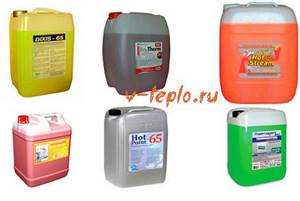
Choosing an “anti-freeze” for heating
Tip number one: buy and fill in antifreeze only in extreme cases - for periodic heating of remote country houses, garages or buildings under construction. Try to use water - regular and distilled, this is the least troublesome option.
When choosing a frost-resistant coolant, follow the following recommendations:
- If your budget is limited, take ethylene glycol from any well-known brand - “Teply Dom”, Dixis, Spektrogen Teplo Coolant, Bautherm, Termo Tactic or “Thermagent”. The cost of the concentrate -65 °C from Dixis is only 1.3 USD. e. (90 rubles) per 1 kg.
- If there is a danger of antifreeze getting into household water (for example, through an indirect heating boiler, double-circuit boiler), or you are very concerned about the environment and safety, buy harmless propylene glycol. But keep in mind: the price of the chemical is higher; a ready-made Dixis solution (minus 30 degrees) will cost 100 rubles (1.45 USD) per kilogram.
- For large heating systems, we recommend using premium class HNT coolant. The liquid is made on the basis of propylene glycol, but it has an increased service life of 15 years.
- Do not buy glycerin solutions at all. Reasons: sedimentation in the system, too high viscosity, tendency to foam, a large number of low-quality products made from technical glycerin.
In the light of the flashlight, tiny white flakes are visible - a sediment of technical glycerin
- Electrode boilers require a special liquid, for example, HNT-35. Before use, be sure to consult with a representative of the manufacturer.
- Do not confuse automobile antifreezes with chemicals used in heating systems. Yes, both formulations are glycol-based, but the additive packages are completely different. Engine coolant is not compatible with residential water heating.
- For open and gravity-flow heating systems, it is better to use water, or, in extreme cases, propylene glycol diluted at minus 20 °C.
- If the heating distribution is made with galvanized pipes, there is no point in purchasing glycol mixtures. The substance will deal with zinc, lose the package of additives and quickly degrade.
Clarification. It is not profitable to use frost-resistant liquid for an open heating system. Hot antifreeze will evaporate into the atmosphere through the expansion tank, the antifreeze will have to be constantly topped up, and money will be spent. It is unacceptable to pump in ethylene glycol, since its vapors are toxic.
There is a lot of debate about the harmfulness of ethylene glycol compounds, including on the pages of construction forums. Without denying the harmful effects of the chemical on human health, let us draw attention to a convincing fact.
Homeowners whose closed systems are installed well have been using inexpensive glycol for years without any problems. Let's listen to the expert's opinion in the video:
Coolant for solar systems
This is justified by the fact that solar heating systems have become particularly widespread in recent years. Coolants for heating systems in this case are characterized by increased thermal stability. They must cope with the most critical overheating, sometimes reaching two hundred degrees Celsius.

If we talk more specifically about the coolant for such systems, then the best option is the same propylene glycol. But this substance itself is not able to withstand critical temperatures; for this reason, it is necessary to add special mixtures containing salt, silicone or oil to it. What did you want? Solar systems are extremely high-temperature systems, the temperature in which sometimes reaches 300 degrees!
Selecting a heating medium
It is necessary to decide which coolant will be used in the future at the heating system design stage. After all, the choice of heating boiler, features of other elements, pump performance, etc. will depend on what the pipes are filled with - water or antifreeze.
Important! If there is a possibility that the system will defrost (for example, if the heating boiler unexpectedly stops), then it is, of course, better to choose water.

It is worth noting that antifreeze, when compared with water, absorbs and releases heat worse. Therefore, if you plan to use it, then you need to take care of high power radiators. But the viscosity of antifreeze is higher, which makes it more difficult to distill through pipes. What should be done? Take care of good and powerful circulation pumps. In addition, there are a number of other factors:
- Find out if it is possible to use antifreeze in your specific batteries. The fact is that not all radiators made of bimetal or aluminum can be combined with it.
- If your knowledge is not enough, then do not disdain the help of experienced specialists; get appropriate advice from them.
- Pay special attention to the choice when you plan to use galvanized pipes. Some chemical changes may occur here, such as metal suspensions or poorly soluble precipitates.
- Do not forget that the boiler itself must be selected in full accordance with the coolant used. The fact is that today most manufacturers focus their products on a specific type, often antifreeze. So, in any case, first study the technical data sheet of the boiler, and only then decide on the coolant.
- Antifreeze, unlike the same water, can last five years or, in other words, ten heating seasons. After this it needs to be changed.
Actually, here we have looked at what coolants there are, as well as how to choose the right type.
Is it possible to pour alcohol into heating radiators?
Anyone who has their own heating system in a private house or cottage. Surely, sooner or later, you are faced with the question of what to replace the water with?
Water, for all its ideality, has two serious disadvantages.
It freezes at zero, and what’s even worse is that when it freezes, it expands. Broken pipes, radiators, boilers, pumps, taps, etc. When frozen, all this can be obtained in full.
There are exactly two possible solutions here. Buy ready-made and make it yourself.
The store offers a special liquid that does not freeze. Antifreeze based on ethylene glycol or polypropylene glycol. Its composition is identical to what you pour into the expansion tank of your car. Just slightly different additives.
This antifreeze has exactly two advantages.
• It really doesn't freeze or evaporate.
• It is easy to buy in the store.
It seems that what more could you ask for, this is the ideal solution, but, as always, the devil is in the details.
• It must be completely changed periodically.
• It corrodes the standard seals.
• It has lower heat capacity.
• It is more fluid when static and thicker when in motion than water.
• Those based on ethylene glycol are poisonous, and those based on polypropylene glycol are even more expensive.
The price of a more or less decent antifreeze based on ethylene glycol is 80 rubles/liter, and for those based on polypropylene glycol 120 rubles/liter.
The average volume of a heating system is 100 liters, a total of 5K-12K per coolant. In principle, it’s not particularly expensive. BUT.
It must be completely changed periodically.
Depending on the quality of the additives, every 3-5 years the entire coolant must be completely drained. It is advisable to flush the system. And fill in a new one. This is due to the fact that ethylene/polypropylene glycols are unstable. And without additives they decompose quite quickly. With the formation of insoluble precipitates in the form of flakes. Which happily settle on all sorts of narrowings. There is no point in being confident in the quality of additives. Therefore, 3-4 maximum 5 years and it is necessary to change. And if there is a defect, it may settle down in a couple of years.
It corrodes the standard seals
.
Glycols are quite aggressive, even though they contain additives, but still. Many standard seals in boilers and radiators can fail and leak over time. Therefore, by the way, many manufacturers prohibit using them as a coolant.
•It has lower heat capacity.
Standard ethylene/polypropylene glycol (for temperature -30) has a heat capacity of 3.3-3.5 kJ/kg*K (Water has a heat capacity of 4.18 kJ/kg*K)
That is, to put it simply, glycol needs to be pumped 25% more in volume. And that's not so bad.
It is more fluid when static and thicker when in motion than water.
I won’t write clever terms about kinematic viscosity and so on. I'll go straight to the conclusions. To work with any type of glycol, you may need the next pump in the model range.
That is, if you had a grudfoss 25-40 180 pump, then you will need to install a grudfoss 25-60 180.
If there was grudfoss 25-60 180 then you may need grudfoss 25-80 180, etc.
Yes, this is rude, and not a fact, but the probability is far from zero. And if replacing a conventional pump is not a problem, then nothing can be done with the one built into the boiler. And you will have to embed an additional one, and there are also problems there.
And the fact that it is more liquid (the surface tension film is weaker) can lead to the fact that joints that have never leaked will leak. And it will have to be redone.
Based on ethylene glycol, it is poisonous.
But this, IMHO, is not particularly important; polypropylene glycol manufacturers emphasize this fact more in order to compete with cheaper ethylene glycol. The system is closed and you do not have access to liquid vapor.
Well, basically everything. If all this suits you... then please.
This is a solution of ethyl alcohol, in the forty-degree version known as vodka. (Isopropyl alcohol can be used, but methyl alcohol cannot be used from the point of view of toxicity)
Its advantages are exactly the same as glycols.
• It is inexpensive. (about 35 r/l of finished coolant)
• It does not need to be changed, but only topped up if necessary.
• Does not corrode standard seals.
• Has a slightly higher heat capacity than water (in weak concentrations up to 40%).
• It is almost as fluid when static and almost as fluid when in motion as water.
• Not poisonous. (You can even drink it)
But it also has its drawbacks.
• Fire hazardous at concentrations above 40%. (therefore it is highly undesirable to do more than 39%)
• It evaporates before water.
• Freezing is not so simple.
Therefore it needs to be calculated.
Let's take Ryazan. Cold five days. This is -27 degrees C. This means the minimum for the system is -24 degrees. (Still, it’s a little warmer in the house, and even if it freezes, the alcohol mixture hardly expands and won’t break the pipes)
It turns out that I need it. 34% alcohol mixture. -23.6 gr.
The boiling point of such a mixture is 85 degrees.
Additionally, I will take into account that under pressure the liquid boils at a higher temperature. (You can use the following rule. For 1 atmosphere of pressure above atmospheric, the boiling point increases by 13%) Since on average a typical system is 2 excess atmospheres, then 85 * 1.26 = 107.1 g.
The automation of any boiler is set to a maximum temperature of 90 degrees.
107.1>90. This means that it also passes through boiling.
Total: 34% Not fire hazardous, will not freeze, will not boil. In principle, the 39% mixture gives similar results.
All that remains is to calculate how much alcohol is needed to obtain the required strength.
There is a formula to obtain the required amount of water.
X is the required number of liters of water per liter of alcohol.
N-initial alcohol concentration (typically 96%)
B-required alcohol concentration (in my case 34%)
It turns out 96/34-1 = 1.82 liters of water.
1 liter of alcohol + 1.82 liters of water = 2.82 liters of ready-made solution. 34%
But since very often the initial volume is not known, it is much easier to go not from calculations, but from the readings of an alcohol meter.
The algorithm is simple. You need to get a 34% solution.
1. Fill the system with water.
2. Drain 10 liters of water and pump in 10 liters of alcohol instead.
3. Let the system work for 10-30 minutes (you may have to add water), drain a little and measure with an alcohol meter.
4. If it turns out to be 20%, then roughly 10 liters / 20% we get 1% = 0.5 liters of alcohol. You need to add another 14% or 7 liters of alcohol.
5. Drain 7 liters from the system and fill in 7 liters of alcohol instead.
Yes, it’s rude, and not entirely correct, but quickly and effectively. Among the tools, one Chinese alcohol meter costs 100 rubles.
As a coolant, an alcohol solution is not ideal, and this is primarily due to the need for calculation.
You can’t just take and pour pure alcohol. And you can’t even use vodka, because it’s a fire hazard. Need less than 39 grams.
Temperatures of -25-28 are enough for most regions of Russia, even in dacha mode. And for home use as permanent residence it can be used anywhere.
Otherwise, it does not have all the disadvantages inherent in glycols.
When installing a heating system at home, you should not only choose the right pipes and radiators, but also pay attention to the coolant. Let's find out which coolant to choose for aluminum radiators, what conditions for using such liquids exist.
If the room space is more than 20 sq.m., then installation of an additional radiator is necessary.
Installation of aluminum radiators.
The most common coolant for a heating system is water, but it sometimes leads to numerous difficulties. This is not only corrosion, but also the formation of scale, the need for more frequent cleaning of the system. In addition, water freezes already at temperatures close to zero degrees, pipes and individual circuit elements can simply burst due to thermal expansion. Therefore, it is important not only to choose the right batteries, but also to use a non-freezing coolant. Among the advantages, it is necessary to note complete safety for humans. If the system leaks, there will be no harm to health, while antifreeze is poisonous.
As a coolant, you can use not only ordinary water, but also specially produced antifreeze. Such mixtures do not freeze even at low temperatures, without changing their qualities at all. Each variety has its own limits, this must be taken into account when choosing.
Antifreeze contains special additives that are inhibitors of corrosion and various mineral deposits.
Installation diagram of an aluminum radiator.
But when purchasing, you should choose exactly those compounds that are suitable specifically for aluminum heating radiators. But such coolants also have their drawbacks:
- heat capacity is fifteen percent lower than that of water;
- high viscosity, that is, a pump is required to ensure circulation in the system;
- when heated, strong expansion is observed;
- fluidity is 50 percent higher than that of water, that is, high demands are placed on sealed connections;
- ethylene glycol antifreezes are poisonous and can only be used for single-circuit boilers.
You can make your own radiator mixture. To do this you will need: distilled water and 40% ethyl alcohol.
To use antifreeze in a heating system, it is not always possible to fill in ready-made commercial mixtures. In this case, you can use a coolant that can be easily prepared with your own hands. you ask how is this possible? Everything is very simple, this coolant is a non-freezing mixture of distilled water and forty percent ethyl alcohol. Such antifreeze, prepared with your own hands for the heating system, has the following characteristics:
- the viscosity of the liquid is slightly higher than that of water, but much lower than that of commercial antifreeze;
- fluidity is less than antifreeze, which makes it possible to somewhat reduce the requirements for the tightness of circuit connections. Rubber seals are not damaged when using this particular liquid;
- Alcohol-based mixtures have another advantage, making them an excellent choice for metal radiators. The fact is that alcohol prevents the development of corrosion, and this is important for systems whose destruction can lead to a variety of troubles;
- in this case, it is recommended to use hard water for the heating system, which, together with alcohol, prevents the formation of scale on the internal surfaces. The sediment is formed in solid form; during preventive flushing it is very easily removed from the system;
- when the alcohol content in the mixture is 30 percent or more, it does not evaporate separately;
- The boiling point of the alcohol coolant is approximately equal to the value for ordinary water. That is, when the temperature rises to 85 degrees Celsius, it does not boil with the formation of large masses of steam;
- alcohol in the coolant composition reduces thermal expansion, that is, when freezing, heating pipes and other elements are not damaged.
If you have to choose between water and an alcohol mixture, many experts recommend giving preference to the second option (if the boiler design allows this). The proportions of this composition are calculated based on what temperature values are planned:
If for some reason the boiler is turned off, be sure to drain the hot water from the radiator, otherwise the pipes may burst.
- when the temperature drops to minus 10.6 degrees, the alcohol content should be 20.3 percent;
- when it drops to minus 23.6 degrees, the alcohol content is 33.8 percent;
- when freezing to minus 28.7 degrees, the alcohol content should be 39 percent;
- when reduced to minus 33.9 percent, the alcohol content is 46.3 percent.
When preparing coolant for aluminum radiators, the volume must be calculated based on the fact that one liter of 96% ethyl alcohol contains 960 ml of anhydrous alcohol. To obtain a 33% alcohol solution, you need to divide 96 by 33, which will give a volume of 2.9 liters. When adding 2.9 liters of water to one liter of alcohol, we obtain a 33% alcohol solution, which is an excellent coolant, poured into an aluminum radiator for the heating system. The resulting solution will not freeze even at temperatures down to minus 22.5 degrees.
When should you not use antifreeze? But it is not always possible to use such a convenient and effective coolant as antifreeze for a heating system. If you are still choosing what exactly to use, consider the following factors:
Calculation of the required radiator power.
- It is strictly forbidden to take antifreeze if ion (electrolysis) boilers are used. In them, heating is carried out by passing current through the entire volume of the boiler tank, and this is unacceptable for antifreeze. When designing a home heating system, make sure that it can be used with a certain type of coolant;
- Antifreeze cannot be used in an open system. But in this case, such a ban applies only to those mixtures that are produced on the basis of toxic ethylene glycol; the rest can be used in open circuits, if there is a manufacturer’s indication for this;
- You cannot reduce the temperature to more than minus 20 degrees. This can seriously reduce the characteristics of the additives included in the composition, that is, pockets of corrosion will appear inside the system and scale will appear;
- When making hermetic connections, it is not recommended to use linen winding, which is coated with ordinary oil paint on top. When using antifreeze in heating aluminum radiators, it is allowed to use linen winding only with sealants, since oil paint is easily corroded by antifreeze, and this leads to a complete loss of tightness;
- Antifreeze cannot be used when galvanized fittings and pipes are used for the heating circuit;
- When the boiler heats the coolant to a temperature above 70 degrees Celsius, antifreeze can no longer be used. This value is the limit for most of these mixtures, which have the highest thermal expansion at higher temperatures.
When choosing antifreeze for aluminum radiators, you need to remember some conditions for working with it. These rules are mandatory for use; they will make the operation of the circuit not only more efficient, but also safer:
- The heating system must be equipped with a more powerful circulation pump than is required for conventional water heating. If the length of the circuit is quite large, then it is necessary to install an external installation of the circulation pump;
- installation of a special expansion tank is required, that is, a capacious expansion tank, the volume of which will be approximately twice that required for a traditional water circuit;
- It is recommended to use large-volume aluminum radiators, as well as heating pipes;
- you cannot install automatic air vents; when using antifreeze in the system, you can only install manual taps, for example, Mayevsky;
- When making detachable connections, you can use sealing gaskets only made of paronite, chemically resistant rubber, or Teflon. Many experts advise using linen winding, which is sealed with a sealant that is resistant to ethylene glycol (if a coolant based on it is used);
- It is not recommended to dilute antifreeze with water, but if this is allowed by its composition, then you can only use purified, distilled water. Melt and rain water are absolutely not suitable for this;
- Before pouring antifreeze for aluminum radiators, it is necessary to carry out preparatory work. The entire circuit, including the boiler, should be flushed with water. The timing of replacement is regulated by antifreeze manufacturers, but experts recommend doing this once every two to three years; you cannot leave the coolant in the system for a longer period of time;
- After antifreeze is poured into the system, you should not immediately put a very large load on the boiler, that is, put it at a high temperature. In this case, it is recommended to increase the temperature gradually so that the coolant has time to warm up smoothly. Such a liquid has a lower heat capacity than water, so this condition must be strictly observed.
Special mention should be made about the water coolant. If in cold weather, for various reasons, the boiler is stopped for a long period, then it is necessary to drain all the hot water that may be there from the heating system in order to prevent rupture of the pipes.
Heating a home: how to choose a coolant for a radiator? When choosing antifreeze or any other coolant for a heating system, numerous factors must be taken into account. This must be done at the design stage of the entire heating system, since the water system is not suitable for the use of antifreeze.
If the temperature in the cold season in the general circuit does not fall below five degrees Celsius, then it is best to prefer a type of coolant such as water, but all salt compounds must be removed from its composition as much as possible. When the temperature in the house is expected to drop to sub-zero levels, only antifreeze can be used, since the water will simply freeze under such conditions. To avoid freezing, you can completely drain all water from the heating system, but there is one serious drawback. The fact is that the radiators will fill with air, and this will lead to corrosion in the presence of high humidity.
There is another way to avoid freezing by using water as a coolant, but for this it is necessary to build in special electric heating elements, which will be controlled using temperature sensors or an installed remote control. This option allows you to maintain the temperature level in the system above 5 degrees Celsius, but the cost of the heating circuit increases many times, that is, it is cheaper to immediately install a system designed for antifreeze. When choosing the required antifreeze for the circuit, you should pay attention to the following characteristics:
- extremely low temperature that can be maintained by the coolant;
- the composition of the liquid, its purpose, that is, for which system it is intended;
- purpose of antifreeze. Is the coolant intended to work in aluminum radiators, how does it interact with plastic pipes, rubber, steel elements, etc.;
- length of time for using antifreeze;
- coolant safety. You should pay attention to how safe the liquid is for humans if it is necessary to drain it after its service life has ended).
But the color of antifreeze for radiators does not matter at all, it simply shows what brand the liquid belongs to.
The choice of coolant when installing a heating system is a fairly important part of the operation of the entire circuit. The efficiency of home heating, its safety, and service life depend on the right purchase. Today, for aluminum radiators, which are becoming increasingly popular, several types of coolants can be used. This is ordinary water, antifreeze based on various components and a special mixture of water and ethyl alcohol. The choice of coolant largely depends on what conditions of use of the system are observed, since it is not always possible to fill it.

